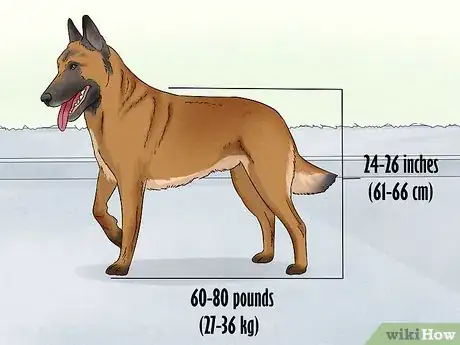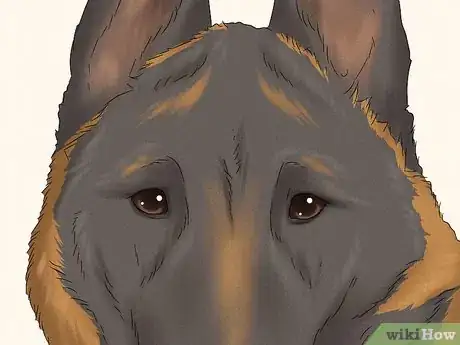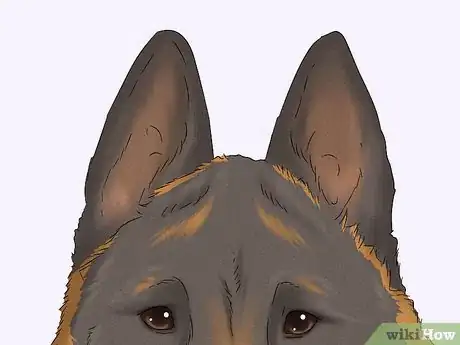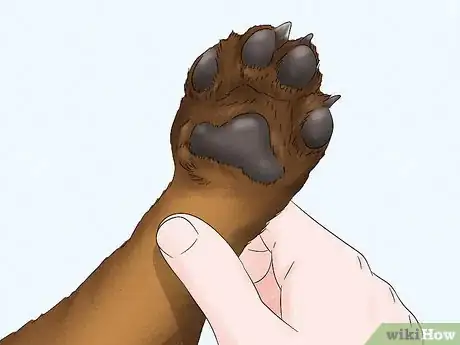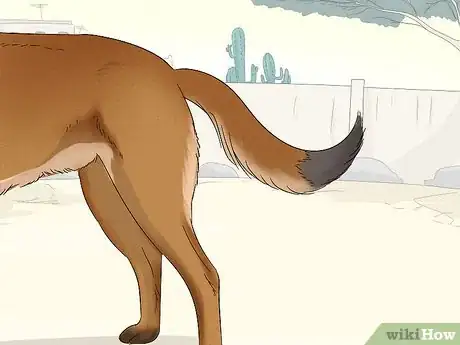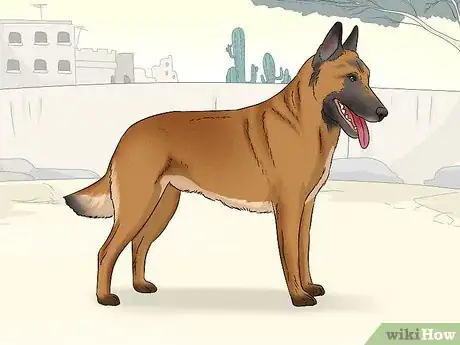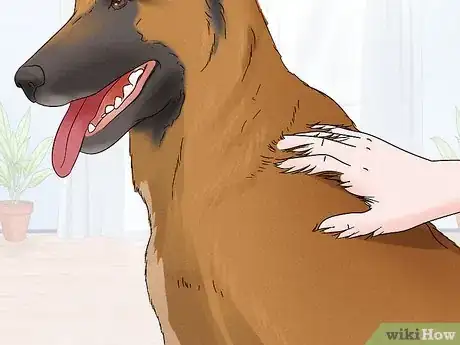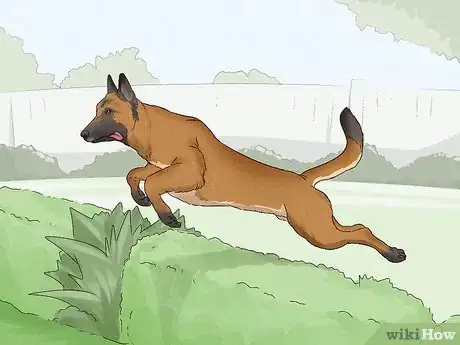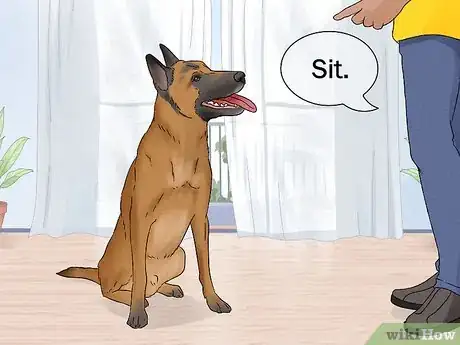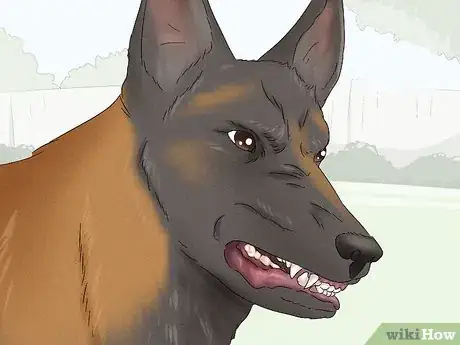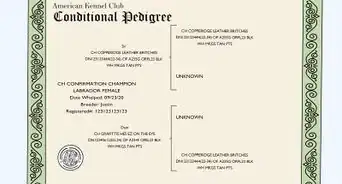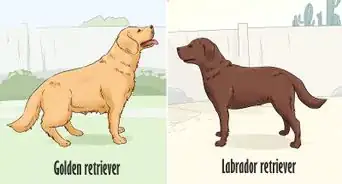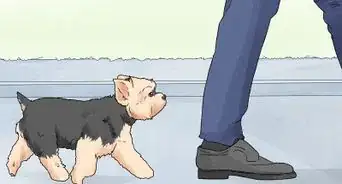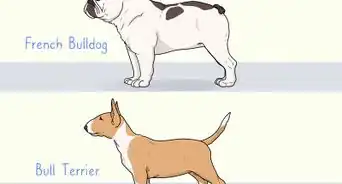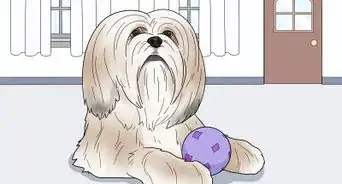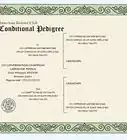This article was co-authored by Colleen Demling-Riley, CPDT-KA, CBCC-KA, CDBC. Colleen Demling-Riley (CPDT-KA, CBCC-KA, CDBC) is a Canine Behavior Consultant and the Founder of Pawtopia Dog Training. With more than 20 years of experience, she specializes in creating and customizing dog management programs for dog owners. She is a Certified Pet Dog Trainer-Knowledge Assessed, Certified Behavior Consultant Canine-Knowledge Assessed, Certified Dog Behavior Consultant, and American Kennel Club Canine Good Citizen Evaluator. Colleen is a member of the International Association of Canine Professionals and has been a featured expert in national media including the New York Times, Woman’s Day, Readers Digest, Cosmopolitan, and Yahoo.com.
This article has been viewed 71,095 times.
The Belgian Malinois is one of four Belgian shepherd breeds (also including the Belgian Laekenois, Tervuren, and Sheepdog), being the most popular among the four and a member of the herding group.[1] Belgian Malinois are distinct from the other Belgian breeds due to their short coats, but they may still be confused with them and other breeds, such as the German Shepherd. Fortunately, this wikiHow will help you identify key Malinois traits to distinguish them from other dogs.
Steps
Viewing the Body Structure
-
1Consider the dog's size. Belgian Malinois are fairly large dogs. Males can weigh anywhere from 60 to 80 pounds (27 to 36 kg) with a height of 24 to 26 inches (61 to 66 cm), and females stand from 22–24 inches (56–61 cm) and weigh 40–60 pounds (18–27 kg).[2]
-
2Check the head. The head of a Malinois is overall proportionate in size to the body and is clean-cut and strong without heaviness, the top being more flattened than rounded. Malinois have moderately pointed muzzles that are approximately equal in length to the topskull. They have a scissors or level bite, a black nose and lips, and an expression of alertness and readiness for activity.[3]Advertisement
-
3Examine the eyes. A Belgian Malinois' eyes are medium-sized and slightly almond-shaped. They are brown in color, preferably dark, and not protruding, with black rims.[4]
-
4Notice the ears. The ears are stiff and erect, proportionate to the head in size. They approach an equilateral triangle shape. The outer corner of the ear should not, if held down, come below the eye's center.[5]
-
5Look at the paws. Belgian Malinois are cat-footed and have round paws that are well-padded. The hind feet may be slightly elongated, and dewclaws are typically removed. The toes curve close together, with strong nails that are usually black but may be white to match white toe tips.[6]
-
6See the tail. A Malinois' tail is strong at the base and the bone reaches the hock. When in action, it is raised with a slight curve without forming a hook and is strongest at the tip.[7]
-
7Inspect the dog's overall structure. Malinois are well-balanced with a square build and appear strong, well-muscled, and agile. They give an impression of solidity and depth without being bulky. Malinois have a round neck, a level topline, long shoulders, a deep chest, and parallel legs. They walk with a smooth, easy, never tiring gait and tend to move in a circle rather than a straight line.[8]
Observing the Coat
-
1Check the appearance and texture of the coat. Belgian Malinois have comparatively short, straight coats. The coat is hard enough to be weather-resistant, includes a dense undercoat, and conforms to the body without hanging down or standing out. The hair on the head, ears, and lower legs is very short and somewhat longer on the tail, backs of the thighs, and neck, where it forms a collarette.[9]
Did you know? In some countries, the Belgian Malinois, Laekenois, Tervuren, and Sheepdog are all considered one breed. The main difference between the four dogs is the coat: Malinois are shorthaired, Laekenois are wirehaired, Tervurens are longhaired with blackened fawn/red coloring, and Sheepdogs are longhaired with black coloring.[10]
-
2Identify the base color. A Malinois' coat is a basic brown in color, ranging from rich fawn to mahogany. The underparts of the body, tail, and breeches may be a lighter fawn, though not a washed-out fawn color.[11]
-
3Look for black markings. Some hairs on a Belgian Malinois have black tips, giving the appearance of an overlay. Malinois also typically have black ears and a black mask on the face.[12]
- Occasionally, a Belgian Malinois may be seen with white markings on the toes or a small white mark on the breastbone (not extending to the neck).[13]
Taking Notice of Temperament
-
1See if the dog is active. Belgian Malinois were originally bred to herd, so it's no surprise that they're very active dogs. They have high energy levels and require regular vigorous activity.[14]
Did you know? Though Belgian Malinois were originally herders, they've proven to be very versatile dogs and have since been seen in not only the show ring but the police force, military, as farm dogs, obedience and agility champions, and more.[15]
-
2
-
3Look for a high prey drive. A high level of prey drive is common in Malinois. A Malinois should be taught to correct any negative behavior relating to their high prey drive at an early age.[17]
-
4Notice if the dog is protective. Belgian Malinois are extremely protective. This, along with their attentiveness and intelligence, make them excellent guard dogs without being overly aggressive.[18]
-
5Check for alertness. Belgian Malinois are very alert and attentive. They are quick and responsive to commands.[19]
Community Q&A
-
QuestionMy 11 month old Belgian malinois is still not good for walks because he always runs. How can I get him to stop this behavior?
 LinnieTop AnswererFocus on training him. It may help to invest in a harness for walks so you can gently tug on the leash to slow him down without injuring him. Reward him when he walks instead of runs, as infrequent as this may be, so that he will be more encouraged to keep a slow pace. Belgian Malinois are known for being intelligent and alert, so he should respond well to training if you keep it consistent and positive.
LinnieTop AnswererFocus on training him. It may help to invest in a harness for walks so you can gently tug on the leash to slow him down without injuring him. Reward him when he walks instead of runs, as infrequent as this may be, so that he will be more encouraged to keep a slow pace. Belgian Malinois are known for being intelligent and alert, so he should respond well to training if you keep it consistent and positive. -
QuestionMy black 15 month old rescue GSD cross or Belgian malinois fits all of the traits for a Belgian malinois but while she's good indoors, outside, anything goes. What should I do?
 VictoriaTop AnswererBecause Belgian malinois are known to be active with a high prey drive, they may run around frequently or chase animals they notice outside. German shepherds also have a lot of energy, and are prone to destructive behaviors like digging, chewing or barking if they are left alone for awhile. Regardless of what breed your dog is, training your Belgian malinois or German shepherd cross can help to correct any of these or other negative behaviors you may notice while the dog is outside.
VictoriaTop AnswererBecause Belgian malinois are known to be active with a high prey drive, they may run around frequently or chase animals they notice outside. German shepherds also have a lot of energy, and are prone to destructive behaviors like digging, chewing or barking if they are left alone for awhile. Regardless of what breed your dog is, training your Belgian malinois or German shepherd cross can help to correct any of these or other negative behaviors you may notice while the dog is outside. -
QuestionDo Belgian malinois have black spots on their tongues?
 LinnieTop AnswererMost commonly, a Belgian malinois has a solid pink tongue. However, they are a breed that is occasionally known to have spotted tongues, and this is completely normal for them.
LinnieTop AnswererMost commonly, a Belgian malinois has a solid pink tongue. However, they are a breed that is occasionally known to have spotted tongues, and this is completely normal for them.
References
- ↑ https://www.akc.org/dog-breeds/belgian-malinois/
- ↑ https://www.akc.org/dog-breeds/belgian-malinois/
- ↑ https://images.akc.org/pdf/breeds/standards/BelgianMalinois.pdf
- ↑ https://images.akc.org/pdf/breeds/standards/BelgianMalinois.pdf
- ↑ https://images.akc.org/pdf/breeds/standards/BelgianMalinois.pdf
- ↑ https://images.akc.org/pdf/breeds/standards/BelgianMalinois.pdf
- ↑ https://images.akc.org/pdf/breeds/standards/BelgianMalinois.pdf
- ↑ https://images.akc.org/pdf/breeds/standards/BelgianMalinois.pdf
- ↑ https://images.akc.org/pdf/breeds/standards/BelgianMalinois.pdf
- ↑ https://www.akc.org/dog-breeds/belgian-tervuren/
- ↑ https://images.akc.org/pdf/breeds/standards/BelgianMalinois.pdf
- ↑ https://images.akc.org/pdf/breeds/standards/BelgianMalinois.pdf
- ↑ https://images.akc.org/pdf/breeds/standards/BelgianMalinois.pdf
- ↑ https://www.akc.org/expert-advice/dog-breeds/getting-right-belgian-malinois-good-fit/
- ↑ https://www.akc.org/expert-advice/dog-breeds/getting-right-belgian-malinois-good-fit/
- ↑ https://dogtime.com/dog-breeds/belgian-malinois#
- ↑ https://www.akc.org/expert-advice/dog-breeds/getting-right-belgian-malinois-good-fit/
- ↑ https://www.akc.org/expert-advice/lifestyle/7-fun-facts-about-the-belgian-malinois/
- ↑ https://www.akc.org/expert-advice/dog-breeds/getting-right-belgian-malinois-good-fit/
